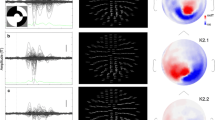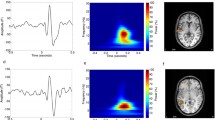Summary
The purpose of this study was to compare the relative efficacy of two methods in assessing the location of the sources of the N100 and P200 components of evoked magnetic fields (EMFs) to transient tone stimuli. EMFs to left ear stimulation, containing both components, were recorded over the right hemisphere of six normal subjects. The magnetic scalp distributions calculated at several adjacent time points, covering the duration of each component's peak, were used to estimate the source parameters of each component. Good estimates of the source of both components were obtained from all magnetic field distributions. The averaged spatial parameters derived from all distributions of each component as well as the parameters derived from the distribution that gave the best source estimate for each component were projected onto magnetic resonance images of subject's head. It was found that the source of each component is located on the superior surface of the temporal lobe and that the source of the P200 component is anterior to the N100 source in all subjects using both procedures.
Similar content being viewed by others
References
Hämäläinen MS, Ilmoniemi RJ, Knuutila J, Reinikainen K (1987) Analysis of magnetoencephalographic data obtained with a four channel SQUID magnetometer. In: Atsumi K, Kotani M, Llenos S, Katila T, Williamson SJ (eds) Biomagnetism 1987. Pergamon Press, New York, pp 299–303
Hari R, Kaila K, Katila T, Tuomisto T, Varpula T (1982) Interstimulus interval dependence of the auditory vertex response and its magnetic counterpart: implications for their neural generation. Electroencephalogr Clin Neurophysiol 54:561–569
Papanicolaou AC, Baumann S, Rogers RL, Saydjari C, Amparo EG, Eisenberg HM (1989) Localization of auditory response sources using magnetoencephalography and magnetic resonance imaging. Arch Neurol (in press)
Pelizzone M, Williamson SJ, Kaufman L (1985) Evidence for multiple areas in the human auditory cortex. In: Weinberg H, Stroink G, Katila T (eds) Biomagnetism: applications and theory. Pergamon Press, New York, pp 326–330
Press WH et al. (1986) Numerical recipes: the art of scientific computing. Cambridge University Press, New York
Rogers RL, Papanicolaou AC, Baumann S, Saydjari C, Eisenberg HM (1989) Nonstationary dynamics of sequential magnetic dipole source changes associated with N100 auditory evoked responses. In: Biomagnetism. Plenum Press, New York (in press)
Sams M, Hämäläinen M, Antervo A, Kaukoranta E, Reinikainen L, Hari R (1985) Cerebral neuromagnetic responses evoked by short auditory stimuli. Electroencephalogr Clin Neurophysiol 61:254–266
Tuomisto T, Hari R, Katila T, Poutanen T, Varpula T (1983) Studies of auditory evoked magnetic and electric responses: modality specificity and modelling. Nuovo Cimento 2D:471–483
Author information
Authors and Affiliations
Rights and permissions
About this article
Cite this article
Papanicolaou, A.C., Rogers, R.L., Baumann, S. et al. Source localization of two evoked magnetic field components using two alternative procedures. Exp Brain Res 80, 44–48 (1990). https://doi.org/10.1007/BF00228845
Received:
Accepted:
Issue Date:
DOI: https://doi.org/10.1007/BF00228845




